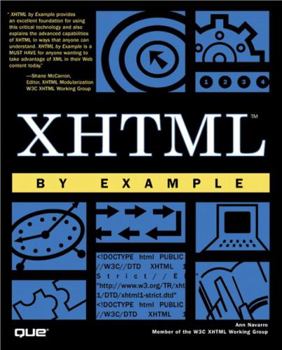XHTML by Example
XHTML by Example explains the differences in syntax between HTML and XHTML, and the concept of 'well-formedness', which is underused in HTML but crucial and required in XHTML. Further coverage... This description may be from another edition of this product.
Format:Paperback
Language:English
ISBN:0789723859
ISBN13:9780789723857
Release Date:September 2000
Publisher:Que
Length:500 Pages
Weight:1.32 lbs.
Dimensions:0.9" x 7.3" x 9.1"
Customer Reviews
1 rating
It shows you how easy it is to transition from HTML to XHTML
Published by Thriftbooks.com User , 23 years ago
In the absence of information about it, many experienced HTML programmers are a bit uncertain about XHTML. Some of this uncertainty is generated by the semantics of the new version rather than the substance. We have gone through the iterations of HTML 1.0 through 4.0 and rather than having a new version numbered 5.0 we have a new name for it. This suggests a fundamental shift in the focus and gives the appearance of increased complexity. That is more appearance than reality. XHTML is HTML based on the organizational structure of XML. Nearly all of the HTML that you have grown to know and love will still work just as well as it did before. Even in the cases where changes need to be made, they are almost always in the direction of greater organization and reduced ambiguity. This book, written and reviewed by members of the W3C XHTML working group, describes all of the differences between HTML and XHTML. As the title suggests, the differences are described by the presentation of short direct examples rather than descriptions and long blocks of code. In general, the explanations are thorough and everyone with an understanding of HTML will have no trouble in following them. There was one omission that I find very puzzling. When using the components that can be placed in an HTML form, the reference names were assigned using the name=" " attribute. However, the XHTML standards are unambiguous when stating, "XHTML 1.0 documents MUST use the id attribute when defining fragment identifiers, even on elements that historically have also had a name attribute." Granted that the current situation often requires that both be used, this omission is the one glaring weakness of the book. XHTML is not a complex extension of HTML. It is in many ways a tightening of the rules, making the creation and parsing of XHTML files cleaner and less ambiguous. This is clearly a direction that the industry will follow and there is no doubt that it is a language that must be learned by all HTML coders. This book will help you do that in a very gentle way.





